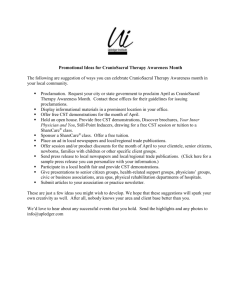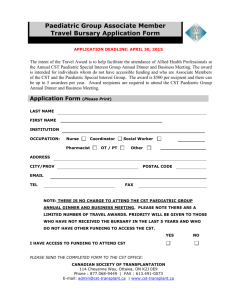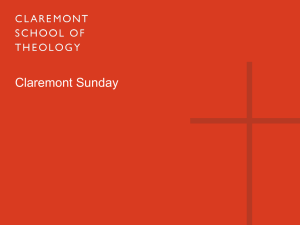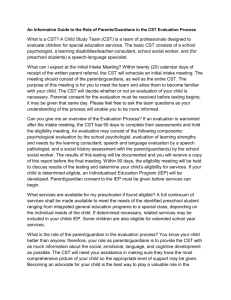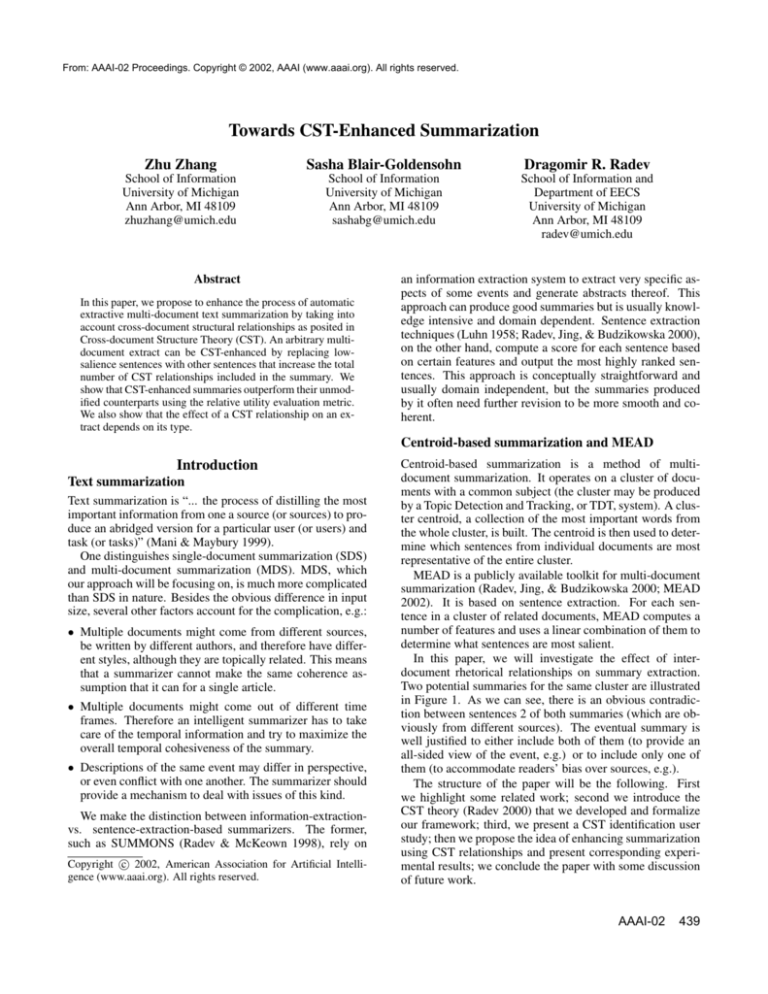
From: AAAI-02 Proceedings. Copyright © 2002, AAAI (www.aaai.org). All rights reserved.
Towards CST-Enhanced Summarization
Zhu Zhang
Sasha Blair-Goldensohn
Dragomir R. Radev
School of Information
University of Michigan
Ann Arbor, MI 48109
zhuzhang@umich.edu
School of Information
University of Michigan
Ann Arbor, MI 48109
sashabg@umich.edu
School of Information and
Department of EECS
University of Michigan
Ann Arbor, MI 48109
radev@umich.edu
Abstract
In this paper, we propose to enhance the process of automatic
extractive multi-document text summarization by taking into
account cross-document structural relationships as posited in
Cross-document Structure Theory (CST). An arbitrary multidocument extract can be CST-enhanced by replacing lowsalience sentences with other sentences that increase the total
number of CST relationships included in the summary. We
show that CST-enhanced summaries outperform their unmodified counterparts using the relative utility evaluation metric.
We also show that the effect of a CST relationship on an extract depends on its type.
an information extraction system to extract very specific aspects of some events and generate abstracts thereof. This
approach can produce good summaries but is usually knowledge intensive and domain dependent. Sentence extraction
techniques (Luhn 1958; Radev, Jing, & Budzikowska 2000),
on the other hand, compute a score for each sentence based
on certain features and output the most highly ranked sentences. This approach is conceptually straightforward and
usually domain independent, but the summaries produced
by it often need further revision to be more smooth and coherent.
Centroid-based summarization and MEAD
Introduction
Text summarization
Text summarization is “... the process of distilling the most
important information from one a source (or sources) to produce an abridged version for a particular user (or users) and
task (or tasks)” (Mani & Maybury 1999).
One distinguishes single-document summarization (SDS)
and multi-document summarization (MDS). MDS, which
our approach will be focusing on, is much more complicated
than SDS in nature. Besides the obvious difference in input
size, several other factors account for the complication, e.g.:
• Multiple documents might come from different sources,
be written by different authors, and therefore have different styles, although they are topically related. This means
that a summarizer cannot make the same coherence assumption that it can for a single article.
• Multiple documents might come out of different time
frames. Therefore an intelligent summarizer has to take
care of the temporal information and try to maximize the
overall temporal cohesiveness of the summary.
• Descriptions of the same event may differ in perspective,
or even conflict with one another. The summarizer should
provide a mechanism to deal with issues of this kind.
We make the distinction between information-extractionvs. sentence-extraction-based summarizers. The former,
such as SUMMONS (Radev & McKeown 1998), rely on
c 2002, American Association for Artificial IntelliCopyright gence (www.aaai.org). All rights reserved.
Centroid-based summarization is a method of multidocument summarization. It operates on a cluster of documents with a common subject (the cluster may be produced
by a Topic Detection and Tracking, or TDT, system). A cluster centroid, a collection of the most important words from
the whole cluster, is built. The centroid is then used to determine which sentences from individual documents are most
representative of the entire cluster.
MEAD is a publicly available toolkit for multi-document
summarization (Radev, Jing, & Budzikowska 2000; MEAD
2002). It is based on sentence extraction. For each sentence in a cluster of related documents, MEAD computes a
number of features and uses a linear combination of them to
determine what sentences are most salient.
In this paper, we will investigate the effect of interdocument rhetorical relationships on summary extraction.
Two potential summaries for the same cluster are illustrated
in Figure 1. As we can see, there is an obvious contradiction between sentences 2 of both summaries (which are obviously from different sources). The eventual summary is
well justified to either include both of them (to provide an
all-sided view of the event, e.g.) or to include only one of
them (to accommodate readers’ bias over sources, e.g.).
The structure of the paper will be the following. First
we highlight some related work; second we introduce the
CST theory (Radev 2000) that we developed and formalize
our framework; third, we present a CST identification user
study; then we propose the idea of enhancing summarization
using CST relationships and present corresponding experimental results; we conclude the paper with some discussion
of future work.
AAAI-02
439
S1: A Gulf Air Airbus A320 carrying 143 people from Cairo,
Egypt, to Bahrain crashed today in the Persian Gulf.
S2: A320 has a good accident record; the crash in the Persian
Gulf today that killed 143 people was the aircraft’s fourth air
disaster.
S3: ...
S1: A Gulf Air Airbus A320 carrying 143 people from Cairo,
Egypt, to Bahrain crashed today in the Persian Gulf.
S2: A320 has been involved in six accidents, including
Wednesday’s.
S3: ...
Figure 1: Two sample summaries
Related work
Our work bears a strong connection to Rhetorical Structure
Theory (RST) (Mann & Thompson 1988), which is a comprehensive functional theory of text organization. RST offers an explanation of the coherence of texts by positing the
existence of coherent relations among text spans. Most relations consist of one or more nuclei (the more central components of a rhetorical relation) and zero or more satellites
(the supporting component of the relation). An example of a
RST relation is ”evidence”, which is decomposed into a nucleus (a claim) and a satellite (text that supports the claim).
RST is intentionally limited to single documents as it is
based on the notion of deliberate writing. In contrast, Crossdocument Structure Theory (CST), the theory that we propose, will attempt to discover rhetorical structure in sets of
related textual documents. Unlike RST, we cannot rely on
the deliberateness of writing. We can, however, make use of
some observations of structure across documents that, while
clearly not deliberate in the RST sense, can be quite predictable and useful.
A recent representative work on RST and its applications
is (Marcu 1997). He proposes a first-order formalization
of the high-level, rhetorical structure of text, and provides
theoretical analysis and empirical comparison of four algorithms for automatic derivation of text structures. A set of
empirically motivated algorithms are designed for rhetorical parsing, i.e., determining the elementary textual units
of a text, hypothesizing rhetorical relations that hold among
these units, and eventually deriving the discourse structure
of the text. Most relevant to our work, Marcu explores using
RST for summarization. The basic idea of the discoursebased summarization algorithm is to induce a partial ordering on the importance of the units in a text based on the text
structure, and output the most important units according to
a certain threshold.
Another significant piece of work that inspired ours is
(Salton et al. 1997). The authors generate intra-document
semantic hyperlinks (between passages of a document which
are related by a lexical similarity higher than a certain
threshold) and characterize the structure of the text based
on the intra-document linkage pattern. They represent each
single document in the form of text relationship maps. A
text summary is generated by selectively extracting important paragraphs from the text, more specifically, by automatically identifying the important paragraphs in a text relation-
440
AAAI-02
ship map and traversing the selected nodes in text order or
along a certain path. The assumption underlying their technique is that highly ”bushy” nodes are more likely to contain
information central to the topic of the article.
All summarization techniques described above are limited
to one single document. What we present in this paper is a
more general framework for multi-document summarization
using cross-document rhetorical relationships. We get better
summaries by taking these relationships into account.
Cross-document Structure Theory
We propose Cross-document Structure Theory (CST), which
enables multi-document summarization through identification of cross-document rhetorical relationships within a cluster of related documents. The proposed taxonomy for CST
relationships can be found in Table 1. Notice that some
CST relationships, such as identity, are symmetric (multinuclear, in RST terms), while some other ones, such as subsumption, do have directionality, i.e., they have nucleus and
satellite. Some of the relationships are direct descendents of
those used in (Radev & McKeown 1998). However, in CST,
the relationships are domain-independent.
Whereas Marcu relied on “cue phrases” in implementing
algorithms to discover the valid RST “trees” for a single document, such a technique is not very plausible for discovering CST “links” between documents. For instance, the “cue
phrase” “although statement X, statement Y” might indicate
the RST relationship “concession” in some circumstances.
Marcu is able to use these phrases for guidance because of
the conventions of writing and the valid assumption that authors tend to write documents using certain rhetorical techniques. However, in the case of multiple documents and
CST inter-document relationships (links), we cannot expect
to encounter a reliable analog to the cue phrase. This is because separate documents, even when they are related to a
common topic, are generally not written with an overarching structure in mind. Particularly in the case of news, we
are most often looking at articles which are written by different authors working from partially overlapping information as it becomes available. So, except in cases of explicit
citation, we cannot expect to find a static phrase in one document which reliably indicates a particular relationship to
some phrase in another document.
How, then, to approach the problem of discovering CST
relationships in a set of documents? We present in a later
section an exploratory experiment, in which human subjects
were asked to find these relationships over a multi-document
news cluster.
Formalization of the problem
Extractive summarizer
Suppose we have a document cluster C, which contains documents d1 through dl ; each document di entails a list of sentences s1 through sni . The set of all sentences in the cluster
is defined as S.
An extractive summarizer E produces an extract S , such
that S ⊂ S. Technically, an extract is simply a condensed
representation of a summary, i.e., there is a one-to-one map-
Relationship
Identity
Contradiction
Description
The same text appears in more
than one location
Two text spans have the same
information content
Same information content
in different languages
S1 contains all information in S2,
plus additional information not in S2
Conflicting information
Historical
Background
S1 gives historical context
to information in S2
Citation
S2 explicitly cites document S1
Modality
S1 presents a qualified
version of the information in S2,
e.g., using “allegedly”
S1 presents an attributed
version of information in S2,
e.g. using “According to CNN,”
S1 summarizes S2.
Equivalence
(Paraphrase)
Translation
Subsumption
Attribution
Summary
Follow-up
Indirect speech
Elaboration
/ Refinement
Fulfillment
Description
Reader
Profile
Change of
perspective
S1 presents additional information
which has happened since S2
S1 indirectly quotes something
which was directly quoted in S2
S1 elaborates or provides
details of some information
given more generally in S2
S1 asserts the occurrence
of an event predicted in S2
S1 describes an entity mentioned
in S2
S1 and S2 provide similar information
written for a different audience.
The same entity presents
a differing opinion or presents a fact
in a different light.
Text span 1 (S1)
Tony Blair was elected for
a second term today.
Derek Bell is experiencing a resurgence
in his career.
Shouts of “Viva la revolucion!”
echoed through the night.
With 3 wins this year, Green Bay
has the best record in the NFL.
There were 122 people on the
downed plane.
This was the fourth time a member
of the Royal Family has
gotten divorced.
Prince Albert then went on to say,
“I never gamble.”
Sean “Puffy” Combs is reported to
own several multimillion dollar estates.
Text span 2 (S2)
Tony Blair was elected for
a second term today.
Derek Bell is having a
“comeback year.”
The rebels could be heard shouting,
“Long live the revolution”.
Green Bay has 3 wins this year.
According to a top Bush advisor,
the President was alarmed at the news.
The President was alarmed to hear
of his daughter’s low grades.
The Mets won the Title in seven
games.
After a grueling first six games,
the Mets came from behind
tonight to take the Title.
So far, no casualties from the quake
have been confirmed.
“I’ll personally guarantee free
Chalupas,” Mr. Cuban announced
to the crowd.
Most students at the University are
under 30.
102 casualties have been reported
in the earthquake region.
Mr. Cuban then gave
the crowd his personal guarantee
of free Chalupas.
50% of students are under 25;
20% are between 26 and 30;
the rest are over 30.
After traveling to Austria Thursday,
Mr. Green returned home to New York.
Greenfield, a retired general
and father of two, has declined
to comment.
The Durian, a fruit used
in Asian cuisine, has a strong smell.
Giuliani criticized the Officer’s
Union as “too demanding”
in contract talks.
126 people were aboard the plane.
The Duke of Windsor was divorced
from the Duchess of Windsor
yesterday.
An earlier article quoted Prince
Albert as saying “I never gamble.”
Puffy owns four multimillion dollar
homes in the New York area.
Mr. Green will go to Austria
Thursday.
Mr. Greenfield appeared in court
yesterday.
The dish is usually made with
Durian.
Giuliani praised the Officer’s
Union, which provides legal
aid and advice to members.
Table 1: CST relationships and examples
AAAI-02
441
ping between extracts and summaries. We will not distinguish these two terms from now on.
The summarizer E can be characterized by the following
components:
1. A scoring algorithm AS that computes a numeric score,
which is a function of a number of features, for each
sentence. Specifically, score(si ) = AS (f1i , f2i , . . . fki ),
where f1 through fk are the features of each sentence.
2. A re-ranker R that adjusts sentence scores by looking at
some other (usually global) information, such as lexical
similarity or CST relationships between pair of sentences.
Specifically, score(si ) = score(si ) + ∆(S), where the
adjustment is determined is by certain global information
with regard to S. Notice that ∆ can be negative.
3. A compression ratio r, such that 0 ≤ r ≤ 1.
4. A ranking algorithm AR that selects the highest-score
sentences, such that NS = NS · r where NS is the
number of sentences in the original text and NS is the
number of sentences in the extract.
CST connectivity
For any extract S , we can define a connectivity matrix M ,
the elements of which are defined as:
mij =
1
0
: connectivity condition holds
: otherwise
The CST connectivity of the extract S is defined as
χ=
NS NS mij
i=1 j=1
.
Depending on our purposes, we could define different
connectivity conditions for the elements in the connectivity
matrix to be equal to 1. In our study, we define the condition as existence of a certain relationship with agreement
strength higher than a certain threshold.
CST identification
In this section, we present an experiment in which subjects
were asked to analyze a set of documents using the set of
proposed relationships in Table 1. We then present the experimental results and consider the implications for further
work in CST.
Experiment 1: establishing CST relationships
The experiment which we conducted required subjects to
read a set of news articles and write down the inter-document
relationships which they observed. Specifically, the 11 articles were on the subject of an airplane crash of a flight from
Egypt to Bahrain in August 2000. They were written by several different news organizations and retrieved from online
news web sites in the days following the accident.
The subjects were eight graduate students and one professor. The instructions specified five article pairs comprised of
random pairings from within the eleven articles mentioned
442
AAAI-02
above. No article was included in more than two pairs. For
each pair, the subjects were instructed to first read the articles carefully. They were then instructed to look for and note
down any occurrences of relationships like those in Figure 1.
(Subjects were also provided with the examples shown in
Figure 1 to illustrate each relationship type.) It was stated
in the instructions that the relationships comprised only a
“proposed” list, and were not to be considered exhaustive.
Subjects were invited to make up new relationship types if
they observed cross-document relationships which did not
correspond to those in Table 1.
Although subjects were given examples of the proposed
relationships at the sentence level, the instructions also explicitly stated that it was possible for a relationship to hold
with one or both text spans being more than one sentence
long. There was no provision for subjects to mark text spans
shorter than a full sentence. Subjects were instructed not to
pay attention to possible intra-document rhetorical relationships. Also, subjects were instructed that it was possible for
more than one relationship to exist across the same pair of
text spans, and to note down as many relationships as they
observed for each pair of text spans.
Results
A summary of the raw results of the experiment is shown in
Table 2. The relationships are presented in descending order
of observed frequency. On average, each subject identified
approximately 45 occurrences of the proposed relationships.
The relationships “Elaboration/Refinement,” “Equivalence,”
and “Description” were identified most frequently. Other
relationships, such as “Translation,” “Citation,” and “Summary,” were observed either never or only by one subject.
Although subjects were encouraged in the study instructions
to name new relationships, none did so.
Relationship Type
Elaboration / Refinement
Equivalence
Description
Historical Background
Follow-up
Subsumption
Contradiction
Attribution
Identity
Indirect speech
Fulfillment
Modality
Summary
Reader Profile
Change of Perspective
Translation
Citation
Total
Sum
85
70
64
44
42
39
31
15
7
6
4
2
1
1
1
0
0
415
Average
9.44
7.78
7.11
4.89
4.67
4.22
3.22
1.67
0.78
0.67
0.44
0.22
0.11
0.11
0.11
0.00
0.00
45.44
Table 2: Identifications of CST relationships by type
Table 3 describes the sentence pairs for which judges
noted relationships. The total number of sentence pairs
for all five article pairs assigned was 4579, which is
5
i=1 ni × mi , where i is the number of the article pair, n is
the number of sentences in the first article in the pair, and m
is the number of sentences in the second article in the pair.
Judges Finding a Relationship
No Judges
One Judge
Multiple Judges
Number of Sentence Pairs
4,291
200
88
Table 3: Sentence pairs by number of judges marking a CST
relationship
As can be seen in Table 3, there are 88 sentence pairs for
which multiple judges identify at least one CST relationship.
Table 4 describes the breakdown of these 88 pairs in terms
of inter-judge agreement. Although subjects were permitted
to mark more than one relationship per sentence pair, they
are counted as “in agreement” here if at least one of the relations they marked agrees with one of the relations marked
by another judge.
Discrete Relationship
Types Observed
Only one
More than one
More than one
Judges in
Agreement
All
At least two
None
Sentences
16
35
37
Table 4: Judge agreement on relationship types among sentence pairs marked by multiple judges
extremely helpful. Not only is there a great deal of transcription (and associated possibilities for error) involved in running this experiment on paper, but a number of subjects expressed the belief that an automated tool would allow them
to provide better and more consistent data.
CST-enhanced summarization
Motivation
In our experiments with CST-enhanced summarization, we
try to explore the effects of different CST relationships on
the quality of output summary. A motivating example is illustrated in Figure 2. As the first step, a 10-sentence extract
(denoted by the bold circles) is generated by MEAD from
a 3-article cluster. The original CST connectivity is 1, as is
denoted by the relationship arc between sentence 44 in article 81 and sentence 10 in article 87. Now we try to increase
the CST connectivity of the summary to 2 by including sentence 46 in article 81 (which has a CST relationship with
sentence 26 in article 41) and drop sentence 22 in article 87
(the lowest ranked sentence in the original extract). Based
on linguistic intuition, we postulate the following hypotheses:
Hypothesis 1 Enhancing the CST connectivity of a summary will significantly affect its quality as measured by relative utility.
Hypothesis 2 The effect of the enhancement will be dependent on the type of CST relationship added into the summary.
Observations
Because our data comes from observations about a subset of
document pairs from a single news cluster, it would clearly
be premature to make conclusions about the natural frequencies of these relationships based on the data in Table 2.
Nonetheless, we can at least speculate that human subjects
are capable of identifying some subset of these relationships
when reading news articles.
We obviously need more data before we can say if the lack
of identifications for those unobserved / rarely observed relationships is because of a true lack of frequency or some
other factor. For instance, some of the proposed relationship names, like “modality,” may not be intuitive enough for
judges to feel comfortable identifying them, even when examples are given.
However, the most encouraging data concerns the relatively high level of overlap when multiple judges made an
observation for a sentence. In 51 of 88 cases where more
than one judge marked a sentence pair, at least two judges
concurred about at least one relationship holding for the pair.
Although approximately two-thirds of the marked pairs were
marked by only one judge, the overall data sparseness makes
this ratio less discouraging. Apparently, before we can attempt to build automated means of detecting CST links, we
must have a better understanding of what (if any) empirical
properties reliably indicate CST relationships.
Another key step is to gather further data. In order to
do so, an automated markup tool in the style of Alembic
Workbench (Day et al. 1997) or SEE (Lin 2001) would be
2
2
3
7
10
17
22
26
44
46
Article 41
Article 81
Article 87
Figure 2: Graph representation of a sample cluster
Experiment 2: utility-based evaluation
The setup We produce summaries using MEAD and CSTenhanced version of it and compare the quality of the summaries. A significant difference in terms of summary quality
will indicate the effect of CST enhancement.
First we need to measure the quality of summaries. We
don’t want to have human judges look at a number of summaries and determine how good they are, which is too tedious and too expensive. Therefore we decided to resort
AAAI-02
443
to sentence utility judgement. More specifically, we had 9
judges read the 11 articles in the same cluster used in the
CST identification user study and assign utility scores (0 to
10) to each sentence. We then average the utility score for
each sentence respectively and use the total utility of a summary as a proxy of its quality measure. This way we can
control the amount of the work human judges have to do
and reuse the utility judgement through a large number of
experiments.
To run the experiments, we used the re-ranker module in
MEAD to adjust the content of a summary. In the default
version of MEAD, the re-ranker only looks at the lexical
similarity between the sentence under consideration and the
sentences already in the summary and drop the current sentence if it is too similar to those already in the summary. To
enhance the summary using CST relationship, we ended up
implementing a new re-ranker which includes new sentences
into the summary according to the notion of increasing CST
connectivity and dropping the lowest-ranked sentences correspondingly.
The evaluation metrics we use are the same as those used
in (Radev, Jing, & Budzikowska 2000). All the summary
performance numbers calculated in the experiments are relative utility scores.
The algorithm The algorithm is described in Algorithm 1.
With this rather naive algorithm, we expect to show the feasibility of CST-enhancement, instead of claiming that this is
”the” best way to do it.
In the actual experiments, we used the following parameters:
• Total number of clusters: 10
• Compression ratio: 10% through 30%,
• Total number of CST relationships: 17
• Threshold to hypothesize a CST relationship: 1
Experiments, results and analysis We also consider the
distinction between incoming and outgoing relationships, in
the sense of the directionality of the added relationship according to user judgement (e.g., in Figure 2, incorporating
sentence 46 in article 81 is enhancement by outgoing relationship). The intuition behind this is obviously that some
CST relationships do have directionality and the directionality could potentially make some difference on the resultant
summary.
First we look at the overall effect of CST enhancement
by comparing the average utility of all CST-enhanced summaries and the utility of baseline summaries (Table 5). As
we can see, overall, CST enhancement significantly improves the utility of resultant summary in both incoming and
outgoing scenarios. This justifies our first hypothesis.
Incoming
Outgoing
p-value
0.008
0.026
Sign
+
+
Table 5: Average effect of CST enhancement (The p-values
are for two-tailed pairwise T-tests), average case.
444
AAAI-02
Algorithm 1 Experiment algorithm for CST-enhanced summarization
for all clusters c do
for all compression ratios r do
Produce baseline summary S for cluster c at compression
ratio r using MEAD
Compute relative utility measure for S
for all possible CST relationship R do
SE =CST Enhance(S,R,c)
Compute relative utility measure for SE
end for
end for
end for
Function CST Enhance(S,R,c)
SE = S
Initialize list L to null
for all sentences s in c but not in S do
if s has CST relationship R with any sentence in S then
Add s into L
end if
end for
if L not null then
if N umberOf Elements(L) > 1 then
Randomly choose a sentence s from L
else
Use the only sentence s in L
end if
s0 = lowest ranked sentence in SE with no CST relationship
to other sentences
Add sentence s into summary SE
Drop s0 from SE
end if
Return SE
Does the compression ratio matter? Although we didn’t
experiment with long summaries (r > 0.3) since we believe those wouldn’t make much practical sense, we still expect to observe some preliminary patterns in the data. Table 6 gives the comparison of pre-enhancement and postenhancement summary performance by compression ratio.
There is a tendency that, although not strong enough to be
conclusive, CST-enhancement is relatively more helpful for
shorter summaries.
Incoming
Outgoing
pre-enhancement
post-enhancement
difference
pre-enhancement
post-enhancement
difference
10%
0.242
0.246
0.004
0.242
0.247
0.005
20%
0.287
0.293
0.006
0.287
0.292
0.005
30%
0.322
0.325
0.003
0.322
0.323
0.001
Table 6: Effects of CST enhancement at different compression ratios
To show how we tested our second hypothesis, we present
the results by different CST relationship types in Table 7.
The observations are the following:
• It appears that some CST relationships have no effect on
the quality of enhanced summaries. This is not necessarily true, though, because all the unchanged utility num-
bers are due to the sparseness of user judgement data, in
other words, the enhancement algorithm couldn’t find any
occurrence of these relationships to enhance the baseline
summary.
• Most relationships that do affect the enhanced summary
are ”positive” ones, in the sense that incorporating them
into the baseline summary significantly increases relative
utility.
• Two CST relationships, historical background and description, stand out as potential ”negative” ones, in
that incorporaing them reduces the utility of postenhancement summary to some extent.
CST relationship
Identity
Equivalence
Translation
Subsumption
Contradiction
Historical
Citation
Modality
Attribution
Summary
Follow-up
Indirect speech
Elaboration
Fulfillment
Description
Reader Profile
Change of Perspective
Incoming
p-value Sign
1.000
N
0.007
+
1.000
N
0.011
+
0.044
+
0.131
1.000
N
1.000
N
0.049
+
1.000
N
0.002
+
0.057
+
0.004
+
1.000
N
0.008
1.000
N
1.000
N
Outgoing
p-value Sign
1.000
N
0.032
+
1.000
N
0.006
+
0.002
+
0.491
1.000
N
1.000
N
0.255
+
1.000
N
0.055
+
0.172
+
0.006
+
1.000
N
0.102
1.000
N
1.000
N
Table 7: Effects of different CST relationships (The p-values
are for two-tailed pairwise T-tests), breakdown-by-type case.
In both the ”average” case and ”break-down-by-type”
case, the importance of directionality doesn’t emerge. As
can be again explained by the sparseness of user judgement
data, this is disappointing but not surprising.
Conclusions and future work
In this paper, we showed that taking CST relationships into
account affects the quality of extractive summaries. Moreover, enhancement by adding different types of CST relationships has different effects on resulting summaries.
In the long run, we foresee the following directions in future work:
• The proposed CST relationships (as shown in Table 1)
need more refinement. A reasonably standardized taxonomy should be in place and act as ground for future
research along this line.
• Currently, all CST relationships are based on human
judgement. To automatically enhance summaries in the
light of CST, we need to be able to automatically parse
CST relationships. The first step is to build a CSTannotated corpus.
• It seems both theoretically and empirically interesting to
find more about the connection between RST and CST.
Maybe first identifying the intra-document RST relationships can help CST parsing?
• Having showed that a relatively naive CST-enhancement
algorithm does help in improving the quality of extractive
summarization, we need to find a more intelligent version
of it and to incorporate it into the MEAD summarizer.
• At this moment, either sentence utility scores by user
judgement or sentence ranking scores by MEAD are really ”inherent utility”, in the sense that score(si ) doesn’t
depend on score(sj ). It might be interesting and useful,
however, to pursue the notion of ”conditional utility” of
sentences (thus acknowledging that the utility of one sentence depends on the utilities of other sentences), which
could potentially influence the output of the summarizer.
Acknowledgements
This work was partially supported by the National Science Foundation’s Information Technology Research program (ITR) under grant IIS-0082884. Our thanks go to
Jahna Otterbacher, Adam Winkel, and all the anonymous reviewers for their very helpful comments.
References
Day, D.; Aberdeen, J.; Hirschman, L.; Kozierok, R.;
Robinson, P.; and Vilain, M. 1997. Mixed-initiative development of language processing systems.
Lin, C.-Y. 2001. See - summary evaluation environment.
WWW site, URL: http://www.isi.edu/ cyl/SEE/.
Luhn, H. 1958. The Automatic Creation of Literature Abstracts. IBM Journal of Research Development 2(2):159–
165.
Mani, I., and Maybury, M., eds. 1999. Advances in automatic text summarization. Cambridge, MA: MIT Press.
Mann, W. C., and Thompson, S. A. 1988. Rhetorical Structure Theory: towards a functional theory of text organization. Text 8(3):243–281.
Marcu, D. 1997. The Rhetorical Parsing, Summarization,
and Generation of Natural Language Texts. Ph.D. Dissertation, Department of Computer Science, University of
Toronto.
MEAD. 2002. Mead documentation. WWW site, URL:
http://www.clsp.jhu.edu/ws2001/groups/asmd/meaddoc.ps.
Radev, D. R., and McKeown, K. R. 1998. Generating
natural language summaries from multiple on-line sources.
Computational Linguistics 24(3):469–500.
Radev, D. R.; Jing, H.; and Budzikowska, M. 2000.
Centroid-based summarization of multiple documents:
sentence extraction, utility-based evaluation, and user studies. In ANLP/NAACL Workshop on Summarization.
Radev, D. 2000. A common theory of information fusion from multiple text sources, step one: Cross-document
structure. In Proceedings, 1st ACL SIGDIAL Workshop on
Discourse and Dialogue.
Salton, G.; Singhal, A.; Mitra, M.; and Buckley, C. 1997.
Automatic text structuring and summarization. Information Processing & Management 33:193–207.
AAAI-02
445



